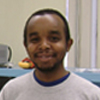Fellows 2009-2010
 Damion Irving 2
Damion Irving 2
Ph.D. (4th. year), Chemical and Biological Engineering
Year in graduate program:5th year (January 2006)
Research Topic:Bio-sensors
Partner School:Bedford Academy
Partner Teacher:Clooney Lavasche
Email Damion
Research
Under the guidance of Prof. Rastislav Levicky, Damion is investigating fundamental aspects of DNA hybridization at solid-liquid interfaces, with applications to the field of biodiagnostics. Biosensor devices use single-stranded DNA as surface-tethered "probes" that interact, through base-sequence specific recognition, with DNA or RNA "targets" from solution. These types of DNA layers can also be used to study DNA-drug or DNA-protein interactions. A central limiting factor in DNA-DNA hybridization is the poor fundamental understanding of how target sequences compete for probes and of how the complex interfacial environment biases the hybridization kinetics and thermodynamics. To this end, Damion has extended existing models for hybridization isotherms to successfully incorporate the role of counterion condensation and rearrangement, and to identify criteria for onset of steric hindrance as a result of surface crowding. Damion is also developing a "map" of hybridization kinetics to better understand how electrostatic and contact interactions influence surface hybridization, and to elucidate how competition between different sequence targets influences approach to equilibrium. Improved understanding of how different DNA targets compete for a specific surface-bound probe is expected to lead to a better diagnostic tool, with more reliable data interpretation algorithms that will improve accuracy of genotyping, functional genomics, DNA based forensics, pathogen detection, drug development, and personalized medicine applications.
Figure: Visible light spectrophotometer TeachEngineering activity developed in the Robotics classroom of Bedford Academy HS. This activity monitors the chemical reaction of common food dyes and bleach, and shows the temperature dependence. It is also used to illustrate similarities in UV spectroscopy, used in Mr. Irving's research with DNA biosensors.
Integration in The Class Room
Damion is using mechatronics as a framework to integrate his research in a 9th grade introduction to robotics classroom and a 12th grade calculus classroom. For the robotics course, he engages students in hands-on team-based projects encompassing the basic prerequisite physics, engineering, and mathematics concepts in robotics. The social implications of robotics are discussed, and the importance of engineering problem solving in society is stressed. As an example, an autonomous robot is built that can navigate through an obstacle course, using a Lego Mindstorms® NXT light sensor and microcomputer. These same components are later used to build a visible light spectrophotometer. These activities demonstrate the breadth of interdisciplinary engineering, and lead to discussion of the societal roles of these and similar technologies. Damion's goal is to build the foundation among his students so that sophisticated sensors being studied in his research are made accessible by analogy to more common solid-state sensors. The equally important awareness of such a technology to change society is repeatedly explored. In the 12th grade calculus classroom, the derivative and its central role in science and engineering are investigated. This is done through engineering problems, and representative open-ended mini projects. While developing the necessary calculus foundation, the class is also introduced to the limitless design possibilities that are available.
Figure: Students assembling a photoresistor circuit, used as a sensor for an autonomous robot. This circuit was also used in the classroom to develop the TeachEngineering activity, "Peering Into the Electric Eye: What is a Photoresistor?"
1 - AMPS Fellow; 2 - CBRI Fellow